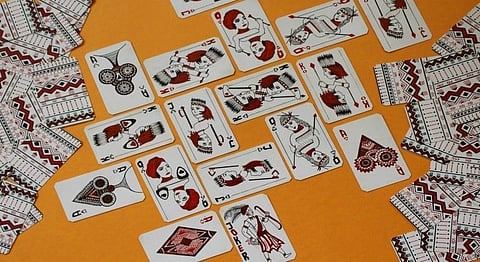
- #HGCREATORS
- #HGEXPLORE
- #HGVOICES
- #HGSHOP
- CAREERS
- ABOUT US
- CONTACT US

Several objects that we use every day are often not designed or created by one person but are mastered over years of iteration and are influenced by a variety of factors such as the geography, socio-political and economic situations, cultural belief systems etc. They may seem simple at first glance, but turn out to be far more complex when one decides to dig deeper. Take the example of an ordinary deck of playing cards, the art of making which has come a full circle today, with the rediscovery of the handmade, practised extensively by the students of CMR University, Bangalore to produce 50 decks of cards, in a variety of unique themes and designs.
In the age of copy-paste-print and mass-manufacture, there is a sense of newness in creating and owning something handmade. Harping upon this thought, The School of Architecture, CMR University, as a philosophy, focuses on a maker-centric curriculum, where the students, through making objects, address intangible and tangible aspects of thinking, learning and eventually designing.
Playing cards were invented back in AD1000, in China in 1360. The 4 suits which started their journey here as goblets, gold coins, swords and polo-sticks, further travelled dynasties, and generations, to evolve into the suits we see in an ordinary deck today – Clover, Spade, Heart and Diamond. The cards through these alterations have always been and continue to be a fascinating play of words, shapes, motifs and hierarchies. The Foundation Studio (in the first year) through a series of exercises, explores concepts of abstraction, form, motifs and pattern making. The ‘design-make-play’ exercise thus embodies the objective of the maker-centricity of the school curriculum. As a part of this exercise, the tutors chose the playing cards to understand, analyse, interpret and redesign.
The Foundation Studio, this semester, thus, started with a game of bluff and continued into the decoding of a typical deck, with the students finding a multitude of sophisticated patterns one would ordinarily ignore. For example, for easy usability most cards are designed symmetrically along the horizontal, eliminating a ‘right-side-up’ decision-making. Each king, queen or jack, though similar at first sight, incorporates slight variations, thus highlighting the individuality of each character. What followed was the design and make stage, where these learnings evolved into numerous yet original packs of cards.
Through an immersion into motif making and story-boarding, students worked on a range of themes chosen by the studio tutors - from bicycles and shoes to rain forests and even Native American tribes. Completely handmade, these playing cards are an assortment of colourful abstract graphics and patterns that have been painstakingly painted onto a range of themed decks. The packs are a result of intense explorations within themes. The rainforest deck, for example, designed by Fathima Saman, a student identifies and breaks hierarchies in the forest ecosystem, describing the parakeet as the king of the forest, the snake as the queen and the bats as jacks.

The bicycle pack, by Sushmitha SM, works with crowned cycle-chariots, with variations in details of the chassis of each cycle. Brundha DC, working with the Native American deck, researched and designed diverse headgears and armaments. Her ace cards went through several graphic iterations before being inked into elaborate baroquesque motifs. The colour palettes, edging, sizing, mediums used were all initial challenges and each decision was taken keeping the thematic and the end user in mind. Completely handcrafted, these decks have become one-of-a-kind artworks, worthy of a collector.

The studio led to almost 50 odd decks, within 15 themes, all equally delightful. With uncountable variations, within 80 students who thought, spoke, sketched, coloured and even dreamt of suits, this rigorous exercise lasted for over fours weeks. What’s left now, is only to gamble away our homemade lunch through a game of poker.
If you wish to buy a pack or get a customized deck of cards, you can write to Akshaya Lakshmi Narsimhan, Assistant Professor, School of Architecture - CMR University (Bangalore) at akshaya.l@cmr.edu.in.
If you enjoyed reading this article, we suggest you read:
